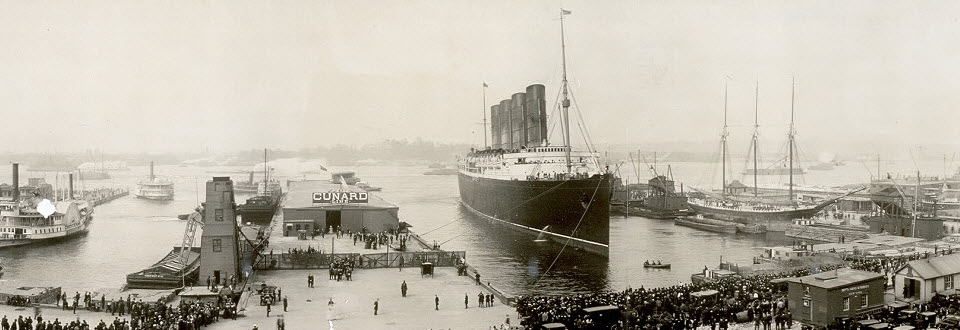What is an Ocean Liner?
Ocean Liners are designed to undertake a line voyage, between point A and point B across a large expanse of open ocean. A great example is a ship built to undertake the transatlantic crossing between North America and Europe. Cruise Ships are typically designed to undertake pleasure voyages, closer to the coast, sailing between ports.
Because of this operational difference, ships designed as Ocean Liners have certain traits to enable them to undertake long duration voyages year after year. Some of these features include:
- A long bow: The bow on ocean liners are typically longer than cruise ships, designed to ensure the superstructure is protected from the waves experienced in the open ocean,
- Strong hull: Ocean Liners are very strong, with steel typically several inches thicker than that used aboard cruise ships,
- Bridge set high atop the ship: Nearly all ocean liners had their navigation bridge on the top most deck. This is to ensure not only a good view but also to protect the navigation from the weather,
- Lifeboat location: Ocean Liners are subject to heavy seas, particularly during winter crossings. As such, the boat deck is usually near the top of the vessel to protect the boats from high seas,
- Speed: Ocean Liners are designed to undertake a scheduled voyage and as such require more speed than cruise ships, largely due to the need to maintain schedules that may be interrupted due to bad weather.
Ocean Liner vs. Cruise Ship
There are only a few ocean liners in service today. For many years, the Cunard QE2 was the last of the transatlantic ocean liner. However in 2004, QM2 became the newest ocean liner in service. Since the retirement of QE2 in 2008, QM2 is the last true transatlantic liner in service.
In contrast, there are over 300 cruise ships in service today. These ships range in size and design, from small super-yacht style vessels to the world’s largest passenger ships: Royal Caribbean’s Icon Class, at over 250,000 gross tons!
Why did all the Ocean Liners retire?
When pressurised aircraft like the Lockheed Constellation and Douglas DC-6 were introduced in the late 40s, aircraft were able to link Europe and America in a matter of hours. But flights linking Australia, America, Asia and Africa required numerous fuelling stops, making the flying experience less than ideal. The Boeing 707 changed all this with better range & speed compared to the piston-driven airliners. Their improved economies led to cheaper tickets; luring more passengers away from ocean liners.
The 707 made its debut on the Atlantic in 1958; tipping the balance in favour of aircraft. The question on many travellers’ minds was: Why spend days travelling by ship when I can cross the Atlantic in a matter of hours by air?
At the same time, containerisation of freight shipping saw liners lose their secondary income source – cargo – and quickened their collapse.
While many lines struggled, several were able to adapt to the jet age, introducing a new style of dual-purpose liner. Examples of these ships include the Home Lines’ Oceanic, Holland America’s Rotterdam and Cunard’s QE2.
Other lines such as P&O were able to adapt existing liners Canberra and Oriana to operate as cruise ships. And cruising was starting to make waves. Passenger ships were no longer just a means to get from place to place.
Now the ship was the destination. And as the popularity of cruising grew there was a new alliance formed between the former foes. Airliners make cruising accessible. While the old ocean liners used to operate direct line voyages between cities, cruise ships often do round-trip voyages from one central hub.
To facilitate this style of travel, Cruise lines rely on airlines to bring passengers to the various cruise ports – a relationship that has allowed for massive growth in cruise hubs such as Miami, Seattle, Vancouver and Genova, as well as provide the economies of scale needed to operate huge fleets of modern cruise ships year-round.
Today there is one ocean liner left in service – Queen Mary 2. Unlike liners of old, QM2 does not compete with aircraft for passengers – but maintains a mode of transport that appeals to people wishing to reconnect with the slower pace of the past.
Image: Courtesy Henderson & Cremer.



